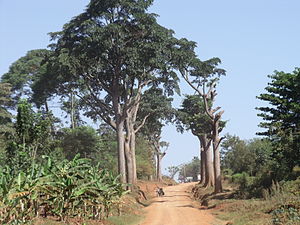Milicia excelsa
| Milicia excelsa | ||||||||||||
|---|---|---|---|---|---|---|---|---|---|---|---|---|

Milicia excelsa |
||||||||||||
| Systematics | ||||||||||||
|
||||||||||||
| Scientific name | ||||||||||||
| Milicia excelsa | ||||||||||||
| ( Welw. ) CC Berg |
Milicia excelsa is a tree in the mulberry family from West and Central Africa to Sudan and southeastern Africa .
description
Milicia excelsa grows as a semi-evergreen tree to over 50 meters high. The trunk diameter reaches up to 1.5–3 meters or more. The buttress roots are usually missing or are only small and narrow. The grayish to brown bark is scaly with age.
The simple, stalked and slightly leathery leaves are alternate. The petiole is up to 5–6 inches long. The leaves are ovate, lanceolate to oblong or obovate and rounded to acuminate, pointed. They are about 9-30 inches long and 5-13.5 inches wide. The leaf blade is often unequal. The leaf margin is whole or slightly indented and often wavy, the young leaves are often toothed to serrate and hairy. The base is slightly heart-shaped to blunt. The leaves are only slightly hairy on the veins above, otherwise glabrous, underneath they are short-haired between the finer veins, otherwise almost glabrous. The veins are pinnate and lighter and slightly raised underneath. The larger stipules are sloping.
Milicia excelsa is dioecious diocesan . Axillary and many-flowered, dense, cylindrical and short-stalked catkins are formed. The male, pendulous and thin, up to 1 centimeter thick inflorescences are much longer and up to 13-30 centimeters long, the female are only small and only 2.5-5 centimeters long, but up to about twice as thick. The unisexual, four-fold and sessile, very small flowers have a simple flower cover and are each accompanied by small bracts . The male, 1.5–2 millimeter long flowers are white, with 4 cup-shaped, overgrown, fine-haired tepals with triangular tips and 4 slightly protruding stamens and a pestle. The slightly larger, female and greenish flowers have four cup-shaped arranged, fine-haired and almost free tepals and a top permanent, single-chamber ovary with two unequal length scars , one is laterally very long, thread-like and the other is only very small, minimal or absent all.
Green, ellipsoidal, about 4.5-5.5 centimeters long, 1.5-2 centimeters thick and fleshy, wrinkled, many-seeded fruit associations are formed. The flattened, orange-brown and round seeds are about 2-3 millimeters in size.
Taxonomy
The first description of Basionyms Morus excelsa took place in 1869 (publ. 1871) by Friedrich Welwitsch in Trans. Linn. Soc. London 27:69, T. XXIII. The reallocation in the genus Milicia took place in 1982 by Cornelis Christiaan Berg in Bull. Jard. Bot. Natl. Belg. 52: 227. Synonyms are Chlorophora alba A. Chev. , Chlorophora excelsa (Welw.) Benth. & Hook.f. , Chlorophora tenuifolia Engl. , Maclura excelsa (Welw.) Bureau and Milicia africana Sim .
use
The fruits are edible. The leaves, roots and bark are used medicinally.
The medium-weight, very durable, but difficult to treat wood is known as African teak , Kambala , Câmbala , or Iroko .
literature
- Quentin Meunier, Carl Moumbogou, Jean-Louis Doucet: Les arbres utiles du Gabon. Presses Agronomiques de Gembloux, 2015, ISBN 978-2-87016-134-0 , p. 232 f, limited preview in the Google book search.
- J. Gérard, D. Guibal, S. Paradis, J.-C. Cerre: Tropical Timber Atlas. Éditions Quæ, 2017, ISBN 978-2-7592-2798-3 , p. 423 ff, limited preview in the Google book search.
- The CABI Encyclopedia of Forest Trees. CABI, 2013, ISBN 978-1-78064-236-9 , pp. 288 f.
- T. Sabu, R. Raj Vikraman, PS Shameer, N. Mohanan: On the occurrence of 'African Teak', Milicia excelsa (Moraceae) in India. In: Rheeda. 28 (2), 2018, pp. 114–117, online at researchgate.net.
- CC Berg, Maria EE Hijman: Flora of Tropical East Africa - Moraceae. Balkema, 1989, ISBN 90-6191-350-0 , pp. 2-5.
Web links
- Milicia excelsa at PROTA.
- Milicia excelsa . In: S. Dressler, M. Schmidt, G. Zizka (Eds.): African plants - A Photo Guide. Senckenberg, Frankfurt / Main 2014.
